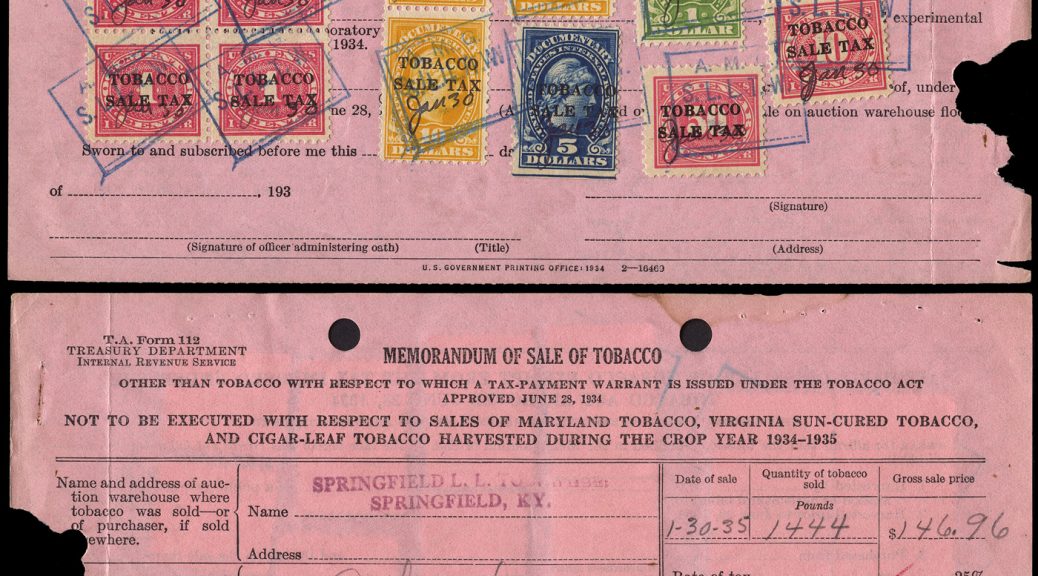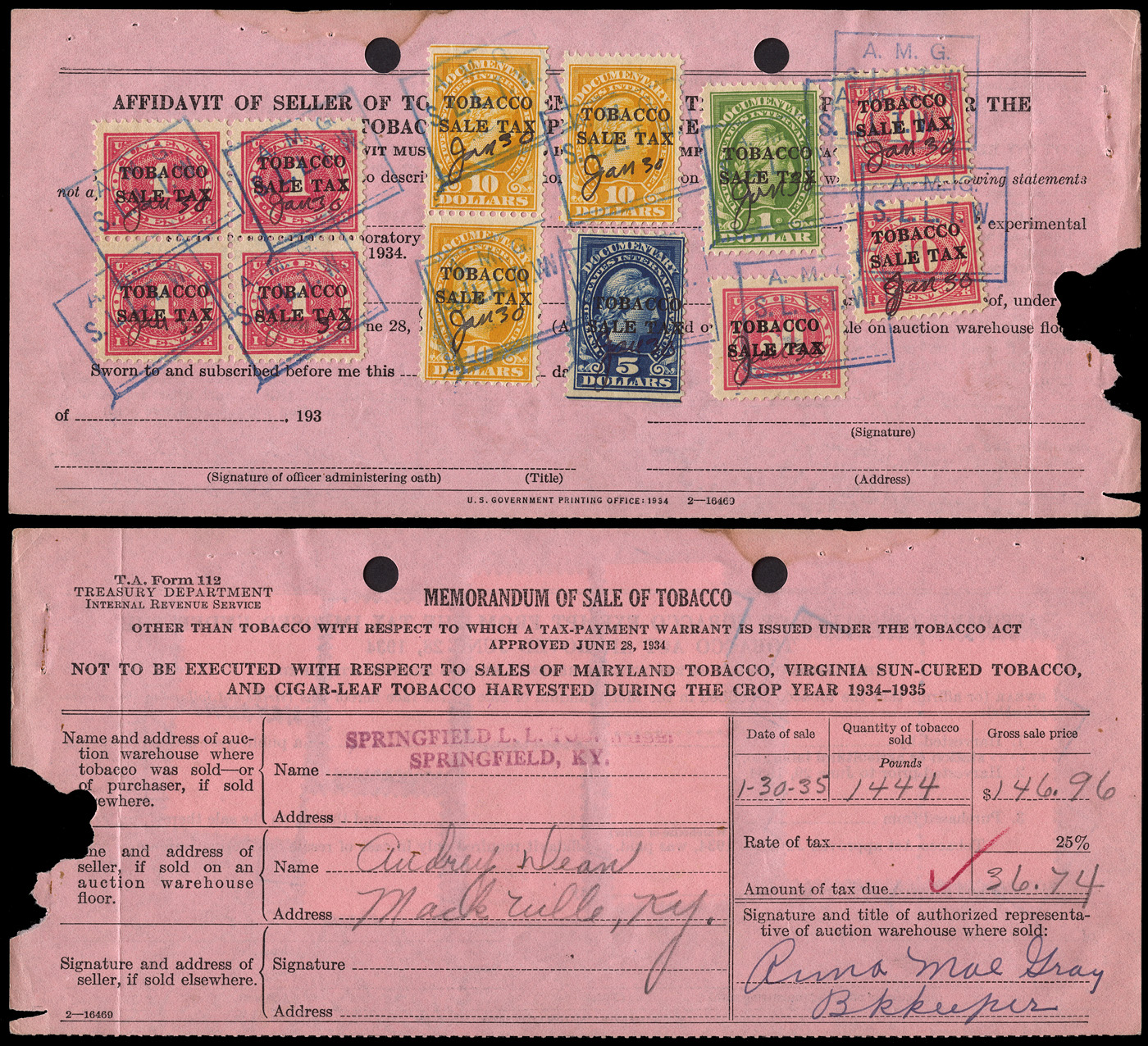
U.S. Revenue Document Types We *Should* See More of in the Market, but Don’t.
… at least based upon the catalog values of the stamps. If the stamps are of nominal value used, then presumably they were used in large quantities, so why don’t we necessarily see them very often still on documents?
This is similar to the threads I’ve made about Scott #J68, the half-cent postage due, of nominal value used, yet try finding one on cover or card paying a fractional cent rate. They’re tough; any example is a $25+ item, with solo usages potentially climbing much higher.
I’ve posted about the paradoxical rarity of Scott #RD1 (1-cent Stock Transfer) on document and how Eric Jackson mentioned searching for years to find one for a client but never did.
I recently had the opportunity to search through several thousand stock transfer slips from the 1920s to 1940s, and it’s not just RD1 that is rare, but also the 1940 1-cent “SERIES 1940” overprint, Scott #RD42. I don’t just mean as solo usages, but in ANY capacity, meaning the scarcity can’t be rate-based.
The scarcity of RD42 on document is interesting to me possibly even more so than RD1. There were numerous printings of Stock Transfer overprints of various denominations in the 22 years between RD1 and RD42. Was a 1-cent denomination even needed in 1940, or was it a statutory requirement?
I think an interesting task would be to go through off-paper used examples of RD1 and RD42 to determine WHEN they were used, to see if there’s any pattern of usage.
I won’t extend this contention of scarcity into the 1-cent greens, as those are bit modern for my focus and I’ve not examined any significant amount of material from that era.
There SHOULD be a lot more of these 1-cent stock transfer stamps on documents, but why aren’t there?
Another document type that while the stamps catalogue a bit more, they still don’t seem to appear frequently enough on documents to align with the catalog values, are “Memorandum of sale of tobacco” (example below) with tobacco sale tax revenue stamps affixed (Scott #RJ1-RJ11).
The stamps themselves don’t catalogue much used. The entire set of RJ1-RJ11 is valued at $36.45 used. The aggregate catalogue value of the stamps on the document above is $40.15.
But darned if these ever appear on the market with any frequency… I’ve been looking.
So are there any other document types that, at least based upon the catalogue values of the stamps themselves, don’t seem to exist with the frequency they should?
From user jconey:
Thinking about your 1 cent quandary and could it be that the transaction amounts probably normally may have exceeded the reasonable use of 1 cent stamps… Meaning they would have to use too many and it was just easier to use higher denominations? Low dollar slips may have found their way to the trash can much more often?
My response:
Even still, you would expect to find them as part of combination usages making up odd-numbered cent totals on higher total tax amounts, e.g., $10.31 tax due, $5.83, etc., where the cent was needed to make up the last digit in conjunction with the other stamps affixed… but even those don’t exist. It’s not that there were only even-numbered cent rates (if that were the case, the 1-cent and 3-cent stamps would never have been needed), and 2-cent, 3-cent, and 4-cent usages can be found easily on document… just not the 1-cent.
From Bart Rosenberg:
With regard to the tobacco sale documents, I just don’t think they were saved for long after use, so collectors never had much opportunity to acquire them. It’s similar in a way to the Producer of Marijuana Special Tax Stamps; there were many thousands used during the WWII era, but farmers don’t appear to have saved anything they had no further use for, so they are rare.
From Ron Lesher:
I have not searched for the 25¢ denomination on document, but would be curious to know how common they are. Here is why. Up to 1924 the Series of 1917 documentary stamps were printed by offset lithography, but beginning in 1924 the BEP had changed to high etch plates.
Now leap ahead to 1934. The Series of 1934 cents denominations of the Silver Tax (Scott prefix RG) and the Tobacco Sale Tax (Scott RJ) were all overprinted on the high etch plates versions EXCEPT the 25¢ denomination which were overprinted on the offset lithography versions that had to be printed more than 10 years earlier. I note that when the perf 10 and perf 11 x 10 versions of the Series of 1917 documentaries were printed these are all from high etch plates and there is NO 25¢ denomination.
So is the 25¢ denomination of the Series of 1917 documentary a relatively little used denomination?
This all from the course (the Series of 1917 Documentary and its overprints) I just taught at APS Summer Seminar.
In general I think it obvious that the revenues beginning in 1914 are both an under appreciated and relatively unexplored field.
My response:
Ron, this is hardly definitive, but I just went through a stack of about 250 stock transfer slips. While the majority of cases needing 25 cents paid were done so with a 20-cent + 5-cent, I found 12 documents with RD7 affixed in various combinations, ranging in date from December 20, 1932 through July 12, 1937. The documents in question were split roughly 50-50 between Chicago and New York firms.
